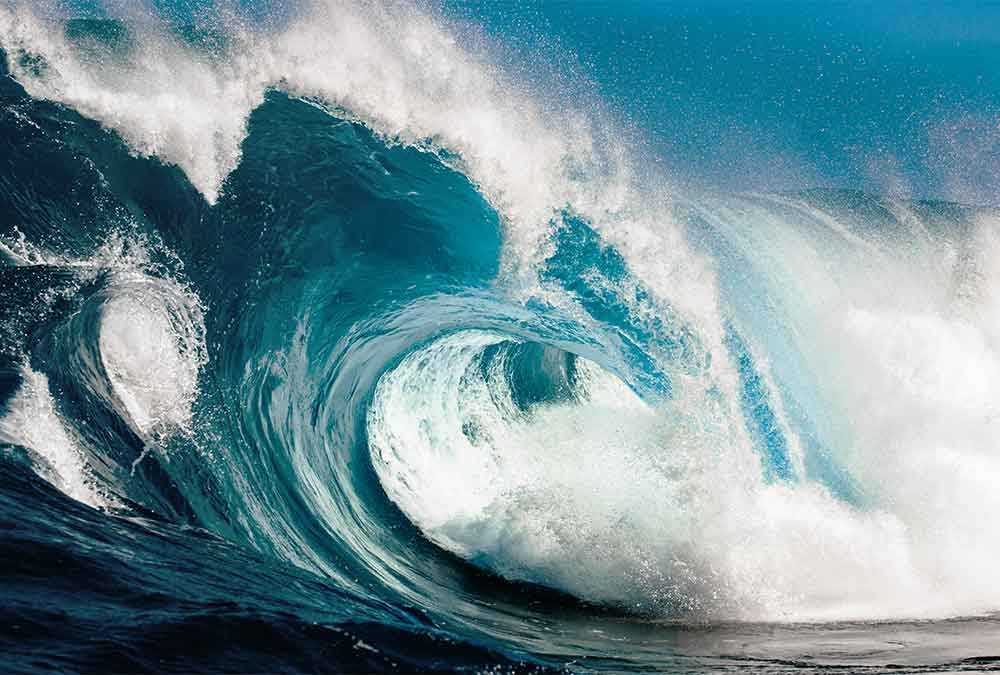table of Contents
- Exploring the Symbolism of Waves in Art
- Techniques for Capturing Movement and Emotion in Wave Paintings
- Reflecting Light and Color: The Role of Waves in Composition
- Incorporating waves into Your own Artistic practice
- Q&A
- Future Outlook
Exploring the Symbolism of Waves in Art
Waves, often depicted as vital elements in various artistic mediums, emerge as powerful symbols that resonate with emotional depth and fluidity. In paintings, they can represent the essence of life itself-ever-changing, dynamic, and unpredictable. Artists utilize the movement and rhythm of waves to evoke feelings ranging from tranquility to turmoil, capturing the ebb and flow of human experience. the layering of colors and textures in these representations often mirrors the complexity of emotions, allowing viewers to connect on a deeper level.
Throughout history, different cultures have imbued waves with unique meanings. For instance, in Japanese woodblock prints, waves often symbolize the impermanence of life, a prevalent theme in Eastern philosophies. Renowned artists like Hokusai have employed dramatic wave motifs, which serve as metaphors for nature’s power but also for the transient beauty of existence. In contrast, Western artistic traditions, especially during the Romantic period, portrayed waves as representations of sublime beauty and the formidable force of nature, reflecting both admiration and fear.
In contemporary art, the artistic representation of waves continues to evolve, pushing boundaries and exploring new techniques. Artists may employ mixed media, digital manipulation, or installation art to engage viewers in multi-sensory experiences. The symbolism of waves in this context often extends beyond mere aesthetic appeal, inviting reflections on environmental issues, the impact of climate change on oceans, or the psychological states of individuals facing life’s uncertainties. Through their innovative approaches, these contemporary works encourage audiences to consider the multifaceted implications of waves, bridging art with social consciousness.
to illustrate the diverse interpretations of waves in art, the following table highlights notable artists and their iconic works featuring wave symbolism:
| Artist | Artwork | Symbolism |
|---|---|---|
| katsushika Hokusai | The Great Wave off Kanagawa | Power of nature and the fleeting nature of human life |
| Caspar David Friedrich | The Sea of Ice | Interplay of beauty and chaos; human insignificance in nature |
| J.M.W. Turner | Shipwreck | Emotional turbulence and man’s vulnerability |
| Claude monet | Impression, Sunrise | Harmony and serenity; the dawn of new beginnings |


Techniques for Capturing Movement and Emotion in Wave Paintings
One of the most powerful techniques for capturing movement in wave paintings is through the use of color gradients. By blending shades from deep blues to bright whites, artists can suggest the dynamic interplay of water and light. The contrast between cool and warm tones can also evoke the temperature of the water, making it feel alive and vibrant. Additionally, the request of color can reflect emotional states; as an example, turbulent waves might be represented with stark contrasts, while gentle swells could feature softer pastels.
Another effective method is the incorporation of brushwork techniques that mimic the fluidity of water. Artists can experiment with various strokes-such as the flick, swirl, or splash-to emulate the movement of waves crashing or rolling in serenity.Incorporating heavy impasto (thick paint) in certain areas can create a tactile sensation of wave texture, while delicate, feathery strokes might convey the lightness of foam. This interplay between techniques not only captures movement but also evokes a sense of emotion, drawing viewers into the depicted atmosphere.
Composition plays a critical role in conveying both movement and emotion.A well-structured composition can lead the viewer’s eye through the painting, reflecting the natural rhythm of the waves. Techniques such as the rule of thirds can be employed to place focal points-such as a cresting wave or a distant ship-strategically within the frame.Additionally, a diagonal arrangement of waves can suggest direction and momentum, giving the viewer a sense of motion and urgency that sparks emotional responses.
| Element | Technique |
|---|---|
| Color | Gradients and contrasts |
| Brushwork | Flicks, swirls, and impasto |
| Composition | Rule of thirds and diagonal arrangements |


Reflecting Light and Color: The Role of Waves in Composition
In the realm of painting, waves are not merely physical phenomena; they embody the essence of rhythm and movement, influencing how light and color are perceived. Artists utilize the interaction between light waves and painted surfaces to create depth and texture, allowing viewers to experience a dynamic visual flow. By manipulating brushwork and color blending, they can mimic the effects of waves, capturing the immaterial quality of light as it dances across surfaces.
One of the most fascinating aspects of light waves in painting is their ability to convey the emotional tone of a piece. Different wavelengths correspond to distinct colors, and artists carefully select their palettes to invoke certain feelings. As a notable example, warm colors like reds and yellows may suggest vibrancy and energy, while cool colors such as blues and greens tend to evoke calmness and serenity.The psychological impact of these colors can be further enhanced by their arrangement and the way the waves of potential light can accentuate or diminish certain hues.
Incorporating patterns that resemble natural waveforms can also add a layer of complexity to a composition. artists often experiment with techniques like glazing, layering, and impasto, employing different wave patterns to guide the viewer’s eye throughout the artwork.Whether depicting the gentle undulation of ocean waves or the sharper peaks of mountain forms, these techniques harmonize the visual elements, creating a cohesive narrative that resonates with the viewer. For example:
| Wave Pattern | Color influence | Emotional Effect |
|---|---|---|
| Sinusoidal | Blue Gradients | Calmness,Depth |
| Jagged | Red Tones | Energy,Tension |
| Spiral | Warm Earthy Hues | Grounding,Stability |
Additionally,artists can employ optical mixing,where the eye blends dots or patches of color that reflect light waves in various ways. By using this technique, a painter can create a sense of luminosity and vibrancy that mimics the sparkling effect of light on water. the careful placement of color waves can intensify the viewer’s engagement, drawing them into the artwork as they perceive the movement and vibrancy created by the overlapping light reflections. In this way, waves in painting become a powerful vehicle for expression and perception, revealing the intricate dance between color, light, and emotion.


Incorporating Waves into Your own Artistic Practice
Incorporating waves into your artistic practice can transform your paintings and infuse them with dynamic energy. The undulating forms of waves can evoke emotions, convey movement, and allow for a deeper exploration of color and texture. By experimenting with various media and techniques,you can create abstract representations that resonate on both visual and emotional levels.
Consider using the following techniques to bring waves alive in your art:
- Layering Colors: Use obvious or semi-transparent layers to simulate the depth and translucence of water.
- Brushwork Techniques: Experiment with different brush styles, from soft blending to bold strokes, to portray the tumultuous nature of waves.
- Texture Creation: Utilize tools such as palette knives or sponges to add physical texture, enhancing the visual experience.
- Mixed Media: Incorporate materials like sand or glass to provide an immersive tactile element that relates closely to the ocean.
Additionally, studying the work of renowned artists can provide inspiration and insight. Artists like J.M.W. Turner and Claude monet famously harnessed the motion of water in their paintings. By analyzing their use of color, light, and form, you can uncover new approaches to expressing waves in your style. Keep track of these elements through a simple reference table:
| Artist | Technique | Wave Representation |
|---|---|---|
| Turner | Loose brushstrokes | Dynamic light effects |
| Monet | color layering | Soft, flowing forms |
In your creative journey, don’t shy away from exploration and innovation. Emphasize the symbolic meaning of waves; they represent change, conflict, and tranquility. Use imagery and concepts associated with waves to tell a story or convey an idea,whether about the ferocity of a storm or the calm of a serene sea. This thematic depth will add layers to your artwork, inviting the viewer to reflect on their own experiences with nature and emotion.
Q&A
Q&A: Exploring “Waves in Paintings”
Q: What significance do waves hold in art and painting?
A: waves in paintings are more than just a representation of the ocean; they symbolize movement, change, and the dynamic nature of life. Artists use waves to evoke emotions, convey energy, and illustrate the power of nature. From the calming lapping of gentle waves to the dramatic churn of a tempest, the varying portrayals of waves can reflect the artist’s feelings or the larger human experience.
Q: How have different art movements approached the depiction of waves?
A: Each art movement has its unique take on waves. For example, Romantic artists like J.M.W.turner captured the sublime power of nature, depicting turbulent seas that convey both beauty and danger. In contrast, Impressionists, such as Claude Monet, focused on the play of light and color on the water’s surface, presenting waves as flickering moments rather than fixed entities. Modern abstract artists might represent waves through bold forms and colors, emphasizing emotional interpretation over realism.
Q: Can you name some famous paintings that feature waves?
A: Absolutely! One iconic piece is Hokusai’s “The Great Wave off Kanagawa,” a woodblock print that has become synonymous with Japanese art. Turner’s “The slave Ship” showcases tumultuous waves reflecting the chaos of a storm.Additionally, Monet’s “Impression, Sunrise” features gentle ripples that are a masterclass in capturing light on water. Each of these works engages with waves in different ways, making them pivotal to the overall narrative.
Q: What techniques do artists use to create the illusion of movement in waves?
A: Artists employ various techniques to suggest movement in waves, including dynamic brush strokes, varying color palettes, and contrasts in light and shadow. Fluid brushwork can mimic the natural flow of water, while layering colors helps to create depth. Some artists might use rapid strokes for turbulent waves,whereas softer strokes convey calm waters. The careful application of perspective also plays a crucial role in giving life to the depiction of waves.
Q: Are there particular colors associated with waves in paintings?
A: Indeed! Blues and greens are traditionally associated with water, symbolizing tranquility and depth. however, the colors can vary widely depending on the context of the painting. For example, bright whites and deep grays might depict crashing waves in a storm, while golden hues can represent sunlight dancing on gentle waters. Artists carefully select colors to enhance the mood and message behind the waves they portray.
Q: How can someone appreciate waves in paintings more deeply?
A: To appreciate waves in paintings,viewers should take a moment to observe the details. Consider the mood of the waves-are they calm or tumultuous? Look for how the artist’s techniques convey movement and emotion. Reflect on the ancient and environmental context behind the artwork. Engaging with the painting both visually and intellectually allows for a richer understanding of how waves reflect broader themes in art and life.
